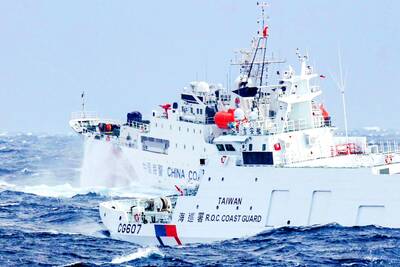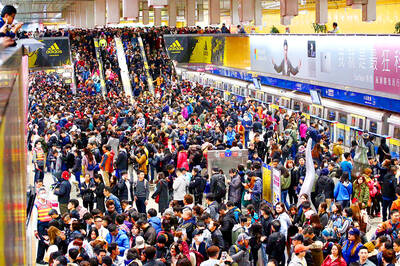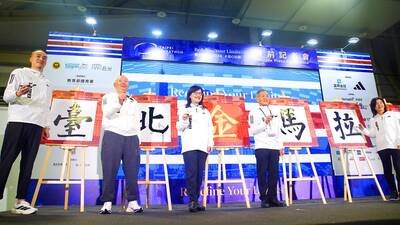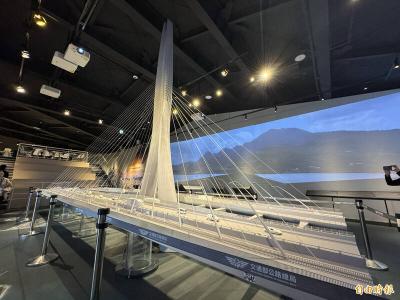When German national Hisham Al-Haroun fought in the Ming Wu Mixed Martial Arts competition in Hsinchu earlier this month, the odds seemed stacked against him.
During six months of training for the competition, Al-Haroun caught cat scratch fever, which caused him to lose 5kg. He also did not have a sparring partner.
Fearing that he was not fit to fight and could be injured, his wife tried to talk him out of participating.
But he insisted on joining the competition.
“I didn’t want people to think I am a chicken, because they didn’t know what’s going on behind the scenes,” Al-Haroun said in an interview with the Taipei Times few days afterwards.
The first five minutes of the round was his moment to shine. With just three weighty kicks, he knocked his Russian opponent to the ground.
Al-Haroun recalled hearing spectators shouting his Chinese name, Chiang Yu-shan (江玉山), and cheering him on.
“In the second round, however, I began to feel the [effect of the] antibiotics I took,” he said.
“[Toward the end] I thought I could turn the match to my advantage in just 10 more seconds, but it was too late. I couldn’t raise my hands and I was out of power. My opponent, also out of power, knocked me out with one punch and I lost,” he said.
But the setback did not daunt the 37-year-old Berliner, who wanted to set a good example for his students. Al-Haroun said he was already prepared for his next fight.
“If a martial arts teacher never had the experience of joining a fight, whatever he taught his students [would only be] theory,” he said.
Everyone loses some time, Al-Haroun said.
“The point is how to stand up and continue. It’s a philosophy of life,” he said.
Now a permanent resident, Al-Haroun first came to Taiwan 13 years ago to deepen his knowledge of Wing Chun (詠春拳), a Chinese martial art he learned while serving in the paratrooper special forces of the German Federal Army.
His fascination with Chinese martial arts, however, began in childhood.
“My father was a Syrian from Damascus and owned a movie theater in Berlin,” he said. “It was in the 70s and the theater was the only one in the city that played Kung Fu movies from Hong Kong, which were all dubbed into German of course.”
As a boy, Al-Haroun would watch films starring Hong Kong action stars Ti Lung (狄龍) or Chen Kwan-tai (陳觀泰) and imitate their moves.
Sometimes, he would invite his friends to watch and they would act out parts of the movies.
After completing his military service, Al-Haroun spent 12 years exploring different martial arts in Asia.
In addition to Wing Chun, he has also studied southern Shaolin-style martial arts like Lohan Quan (羅漢拳) and Wuzhu Quan (五祖拳), as well as Xing Yi Quan (形意拳) and Bagua Quan (八卦拳) in Taiwan.
Al-Haroun recalled an experience he had practicing monkey boxing in Tainan’s Wufu Temple, which is dedicated to the Monkey King.
“I was meditating in the temple before I started practicing one day,” he said. “All of a sudden, I felt that my body was not mine and I kept asking myself: ‘What’s happening to me?’ The next thing I knew, I saw a clear sky and monkeys jumping from one cloud to another. And I started doing moves that I have never learned before.”
Four years ago, Al-Haroun married a Taiwanese woman and the couple opened a martial arts institute in Tainan. As an expatriate certified to give martial arts lessons in Taiwan, he teaches his own combat system, which incorporates his previous trainings in free-style wrestling, taekwondo, karate, monkey boxing and other martial arts.
His students include school-age children, officers of the Tainan City Police Department and members of the Marine Special Forces.
Al-Haroun also participates in martial arts competitions or sometimes coaches participants.
He won the 2007 International World Cup for Sanda in Kaohsiung by taking down his opponent in 23 seconds, although his rival was a head taller than him.
Last year, Al-Haroun coached members of the Marine Special Forces, helping them win four gold medals in the Sanda Championship in Taipei.
When the film Ip Man (葉問) premiered in Tainan last month, Al-Haroun was invited to demonstrate Wing Chun for the audience. Ip was a master and teacher of the martial art.
With the rising popularity of games like Japan’s K-1 Grand Prix, Al-Haroun said many young people had started training themselves to fight in mixed martial arts competitions. But more resources are needed to promote the sport, he said, whether from the government or the private sector.
“The [competition this month] in Hsinchu was a good experience, but that was only one game,” he said. “The payment for fights isn’t much and the risk of getting injured is big. And the winner does not have a prize or anything. So you need sponsors to help train the fighters and provide the rewards.”
Al-Haroun said he wanted to train young and ambitious people in Taiwan to join in international tournaments. He even suggested the possibility of members of the military competing in wrestling or judo competitions overseas.
“The best Russian fighters in the Olympics, for example, are all from special forces in the military, because through fighting competitions they help reflect how strong the country really is,” he said.
He said the Taiwanese had great potential, as seen in the performance of Taiwanese athletes in taekwondo and weightlifting.
“The government needs to make sure the budget goes directly to the athletes and the training. They also need to have the right methods to train the athletes,” he said.
They need support to develop in the right direction, Al-Haroun said.

READY: The CGA said it closely monitored China’s maritime exercise, deployed vessels to shadow the Chinese ships one-on-one and set up emergency response centers Chinese navy and coast guard ships have returned to China, signaling the end of a massive maritime exercise, authorities said yesterday. The Coast Guard Administration (CGA) released images it said showed Chinese vessels sailing north in rough seas past Taiwan on Thursday, on their way to China. “All the Chinese coast guard went back to China yesterday, so although they have not officially made any announcement, we consider it over,” CGA Deputy Director-General Hsieh Ching-chin (謝慶欽) said. Beijing has not confirmed the drills and the Chinese Ministry of National Defense did not say whether the maneuvers had taken place when asked at a

People can take the Taipei MRT free of charge if they access it at Nanjing Sanmin Station or Taipei Arena Station on the Green Line between 12am and 6am on Jan. 1, the Taipei Department of Transportation said on Friday, outlining its plans to ease crowding during New Year’s events in the capital. More than 200,000 people are expected to attend New Year’s Eve events in Taipei, with singer A-mei (張惠妹) performing at the Taipei Dome and the city government’s New Year’s Eve party at Taipei City Hall Plaza, the department said. As people have tended to use the MRT’s Blue or

PUBLIC TRANSPORT: As some roads would be fully or partially closed, people are advised to take the MRT, with services expanded to accommodate more riders This year’s Taipei Marathon, which has obtained its first gold label certification from World Athletics, is to be held from 5am to 1pm tomorrow and would have 28,000 participants. The race is to start from the Taipei City Plaza and would go through major roads throughout the city, with traffic control implemented from 6am to 2pm, officials said. The Taipei Mass Rapid Transit (MRT) system and New Taipei City MRT Circle line would start operating at 5am on the day of the race, they said. The race would cover Renai Road, Xinyi Road, Hangzhou S Road, Aiguo east and west roads,

Upon its completion next year, the new Tamkang Bridge (淡江大橋) in New Taipei City is to be an important landmark in Taiwan, alongside Taipei 101, Minister of Transportation and Communications Chen Shi-kai (陳世凱) said today. The bridge is scheduled to be completed in December next year and open to the public in the first half of 2026, connecting New Taipei City’s Tamsui (淡水) and Bali (八里) districts. It is an asymmetric single-tower suspension bridge, nearly 70 stories tall, designed by world-famous architect Zaha Hadid. The bridge aims to alleviate traffic in Tamsui and on the Guandu Bridge (關渡大橋), in addition to increasing the